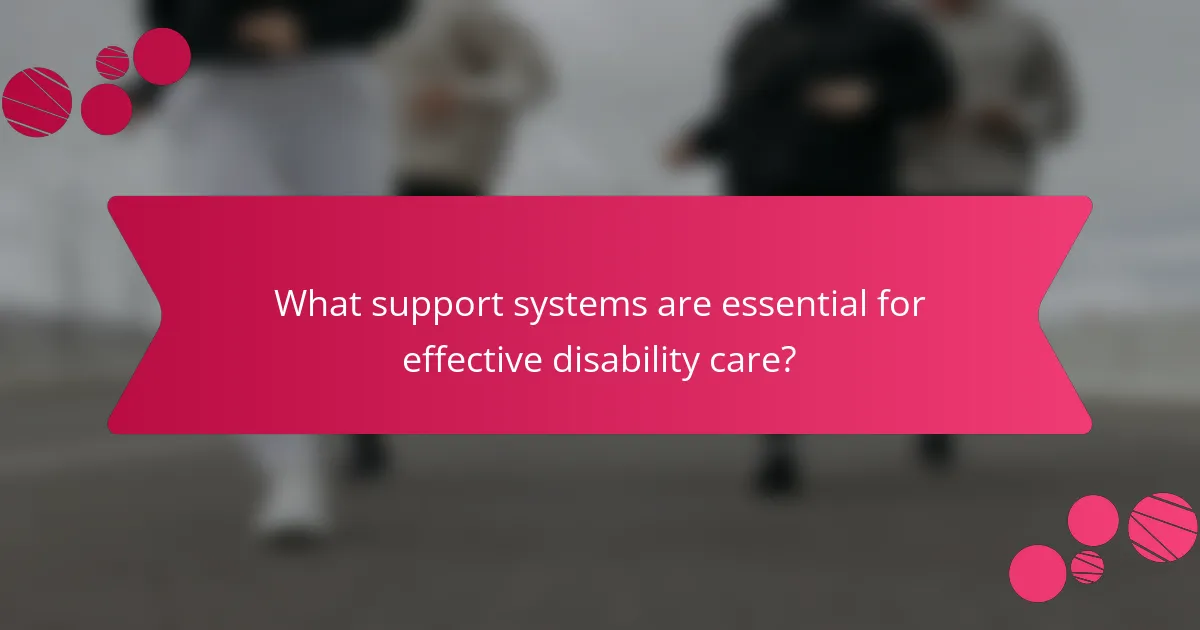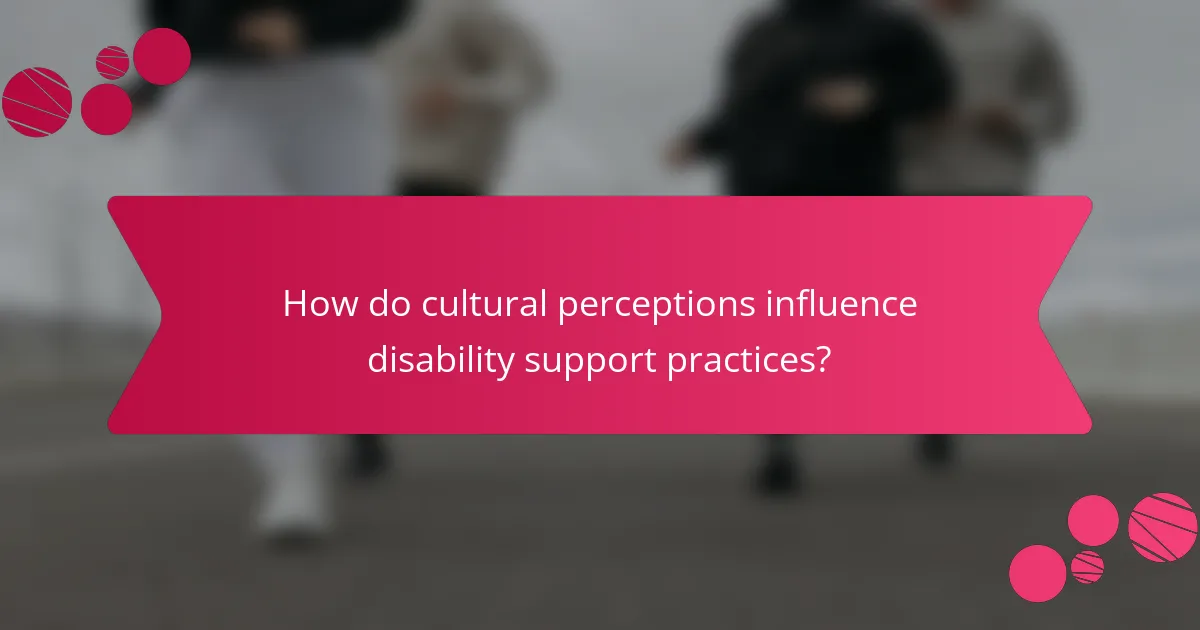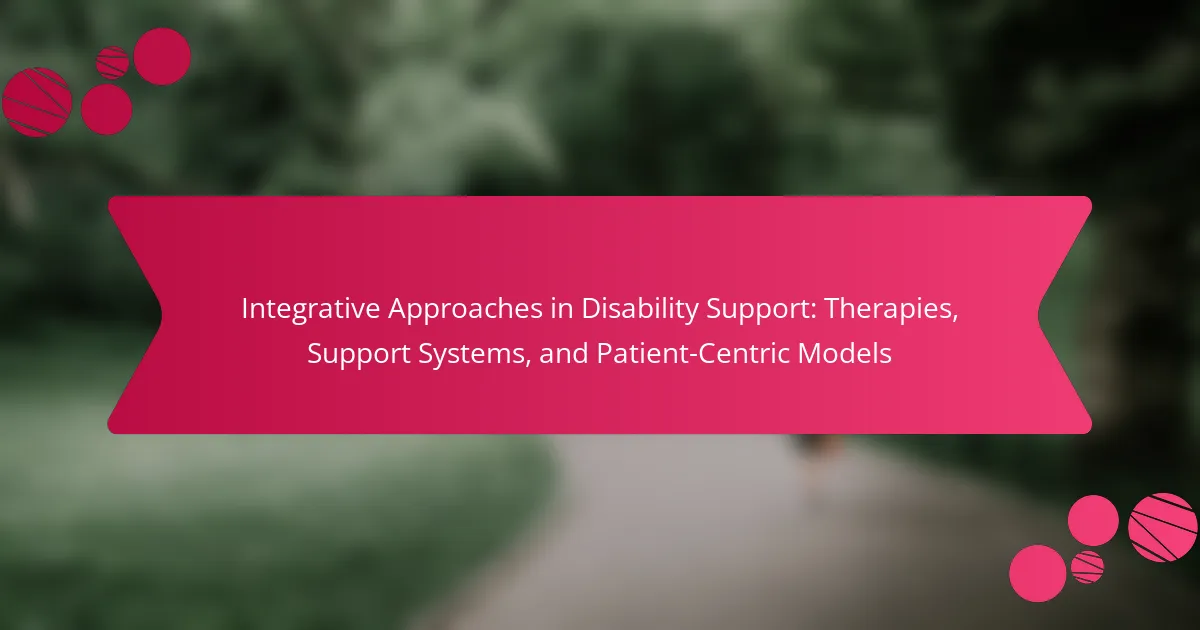Integrative approaches in disability support enhance individual well-being by combining therapies and support systems. This article explores various therapies like cognitive behavioral and occupational therapy, the importance of patient-centric models, and effective support systems. It also addresses cultural perceptions and barriers that impact care, along with metrics for evaluating support effectiveness. Lastly, best practices for implementing integrative strategies will be discussed.

How do integrative approaches enhance disability support?
Integrative approaches significantly enhance disability support by combining various therapies and support systems. These methods focus on the individual, addressing physical, emotional, and social needs collaboratively.
For example, multidisciplinary teams can create personalized care plans that incorporate physical therapy, occupational therapy, and counseling. This holistic view leads to improved outcomes and greater patient satisfaction.
Additionally, patient-centric models emphasize active participation, empowering individuals to engage in their treatment. This approach fosters independence and enhances overall quality of life.
As a result, integrative strategies not only address immediate challenges but also promote long-term well-being and resilience in individuals with disabilities.
What are the key components of integrative disability support models?
Key components of integrative disability support models include collaborative care, personalized therapies, and holistic support systems. These models emphasize teamwork among healthcare providers, tailored interventions based on individual needs, and comprehensive resources to enhance patient well-being. Integrative approaches often incorporate physical, emotional, and social aspects of health to create a supportive environment.
Why is a patient-centric model crucial in disability support?
A patient-centric model is crucial in disability support as it prioritizes individual needs and preferences. This approach fosters better engagement, enhances satisfaction, and improves health outcomes. By focusing on the patient’s unique circumstances, providers can tailor interventions effectively. Research indicates that patient-centric models can lead to a 30% increase in treatment adherence. This model also encourages collaboration among healthcare professionals, ensuring comprehensive support systems that address physical, emotional, and social aspects of disability.

Which therapies are most effective in integrative disability support?
Integrative disability support therapies include cognitive behavioral therapy, occupational therapy, art therapy, and physical therapy. Each therapy addresses different aspects of disability, enhancing overall well-being.
Cognitive behavioral therapy focuses on modifying negative thought patterns, improving mental health outcomes. Occupational therapy enhances daily living skills, promoting independence. Art therapy encourages self-expression, facilitating emotional healing. Physical therapy improves mobility, strength, and function, addressing physical limitations.
These therapies often work synergistically, offering a holistic approach to support individuals with disabilities. Integrating these methods can lead to improved quality of life and better adaptation to challenges.
How does occupational therapy contribute to disability support?
Occupational therapy significantly enhances disability support by promoting independence and improving daily functioning. It focuses on personalized interventions that address individual needs, facilitating skill development and adaptation to various environments.
Therapists assess capabilities and limitations, creating tailored strategies that empower individuals to engage in meaningful activities. By fostering collaboration among healthcare providers, families, and communities, occupational therapy strengthens support systems and enhances overall quality of life for those with disabilities.
This integrative approach not only addresses physical challenges but also considers emotional and social factors, making it a holistic solution in disability support.
What role does physical therapy play in patient recovery?
Physical therapy is crucial for patient recovery as it enhances mobility, reduces pain, and improves overall function. It utilizes tailored exercises and techniques to address individual needs, promoting healing and independence. Effective physical therapy can significantly shorten recovery time and improve quality of life. Evidence shows that patients engaged in physical therapy often achieve better outcomes compared to those who do not participate in such programs.
Which alternative therapies are gaining traction in disability support?
Alternative therapies gaining traction in disability support include acupuncture, mindfulness-based stress reduction, and music therapy. These approaches enhance traditional care by addressing mental and emotional well-being.
Acupuncture offers pain relief and improves mobility for individuals with physical disabilities. Mindfulness-based stress reduction helps manage anxiety and enhances quality of life. Music therapy facilitates communication and emotional expression, particularly in non-verbal patients.
These integrative methods support a holistic model of care, emphasizing patient-centric strategies that cater to individual needs. As a result, they improve overall outcomes in disability support settings.

What support systems are essential for effective disability care?
Effective disability care relies on comprehensive support systems that include healthcare professionals, community resources, and family involvement. These elements create a holistic approach to patient well-being and recovery.
Healthcare professionals offer medical and therapeutic support tailored to individual needs. Community resources provide access to social services, advocacy, and peer support networks. Family involvement fosters emotional support and encourages adherence to care plans.
Integrative approaches enhance these systems by combining traditional therapies with alternative methods, ensuring a patient-centric model. This model prioritizes the unique needs of individuals, promoting better outcomes in disability care.
How do multidisciplinary teams improve outcomes for patients?
Multidisciplinary teams enhance patient outcomes by integrating diverse expertise and perspectives. This collaboration fosters comprehensive care plans tailored to individual needs. For instance, combining physical therapy, occupational therapy, and counseling addresses both physical and emotional challenges, promoting holistic recovery. Studies show that such approaches lead to improved patient satisfaction and reduced hospital readmission rates.
What community resources are available for individuals with disabilities?
Various community resources support individuals with disabilities, including therapy services, support groups, and advocacy organizations. These resources aim to enhance quality of life through integrative approaches.
Therapy services encompass physical, occupational, and speech therapies tailored to individual needs. Support groups provide emotional and social connections, fostering a sense of community. Advocacy organizations work to promote rights and accessibility, ensuring individuals receive necessary support.
Additionally, local government programs often offer financial assistance and educational resources. Nonprofit organizations frequently provide specialized services and training programs, empowering individuals with disabilities. These comprehensive resources create a supportive environment that enhances overall well-being.
Which technological advancements are shaping disability support systems?
Technological advancements are significantly enhancing disability support systems through innovative tools and approaches. Assistive technologies like smart home devices and wearable health monitors improve accessibility and independence. Telehealth services offer remote consultations, increasing access to care. Artificial intelligence aids in personalized therapy plans, adapting to individual needs. Virtual reality is used for rehabilitation, providing immersive experiences that enhance engagement and motivation. These advancements create patient-centric models that prioritize individual preferences and improve overall quality of life.

How do cultural perceptions influence disability support practices?
Cultural perceptions significantly shape disability support practices by influencing attitudes, policies, and service delivery. Societies with inclusive views often implement comprehensive support systems that prioritize patient-centered models. In contrast, cultures with stigmatizing beliefs may restrict access to essential therapies and resources. This disparity highlights the unique attribute of cultural context in shaping support practices, as it directly affects the quality and availability of care. As a result, understanding these perceptions is crucial for developing effective integrative approaches in disability support.
What unique challenges do different demographics face in accessing support?
Different demographics face unique challenges in accessing disability support, including socioeconomic status, cultural barriers, and geographic location. Individuals from lower socioeconomic backgrounds often struggle with limited resources and awareness of available services. Cultural differences can lead to misunderstandings about disability needs and support systems. Rural populations frequently encounter geographic barriers, such as lack of transportation and fewer local services. Tailored, patient-centric models are essential to address these disparities effectively.
How can support systems be tailored to meet diverse cultural needs?
Support systems can be tailored to meet diverse cultural needs by integrating culturally sensitive practices. These approaches enhance accessibility and effectiveness for individuals from various backgrounds.
First, understanding cultural values and beliefs is essential. This knowledge helps in designing support services that resonate with the community. For instance, employing culturally competent staff can bridge gaps in communication and trust.
Second, flexibility in service delivery is crucial. Support systems should adapt to different cultural practices, such as incorporating traditional healing methods alongside modern therapies.
Lastly, ongoing feedback from community members ensures that support systems remain relevant and effective. Regular assessments can identify unique cultural needs, allowing for continuous improvement in service delivery.

What are the common barriers to effective disability support?
Common barriers to effective disability support include inadequate funding, lack of trained professionals, insufficient awareness, and systemic discrimination. These obstacles hinder access to necessary resources and limit the effectiveness of integrative approaches. For example, funding shortages can lead to reduced availability of therapies and support systems. As a result, individuals may not receive the patient-centric care they need. Addressing these barriers is essential for improving disability support outcomes.
How does funding impact the quality of disability support services?
Funding significantly influences the quality of disability support services by determining resource availability and service accessibility. Adequate funding allows for better trained staff, improved facilities, and a wider range of therapeutic options. For example, services funded at higher levels can incorporate advanced technologies and personalized care plans, enhancing patient outcomes. Conversely, underfunding can lead to staff shortages, limited service offerings, and reduced support for individuals with disabilities. This disparity highlights the critical role of financial investment in ensuring effective and comprehensive disability support systems.
What misconceptions hinder access to integrative approaches?
Misconceptions about integrative approaches often stem from a lack of understanding and awareness. Many believe these methods lack scientific validation, which is not true; numerous studies support their efficacy. Others assume that integrative approaches are solely alternative, neglecting their potential to complement conventional therapies. This leads to resistance from both patients and healthcare providers. Additionally, some individuals think these approaches are too time-consuming or expensive, overlooking the long-term benefits and cost savings they can provide. Addressing these misconceptions is essential for improving access to holistic disability support systems.

Which metrics are used to evaluate the effectiveness of disability support?
Metrics used to evaluate the effectiveness of disability support include client satisfaction, functional improvement, service accessibility, and cost-effectiveness. These metrics assess how well support systems meet individual needs and promote autonomy.
| Metric | Description |
|————————–|————————————————–|
| Client Satisfaction | Measures user contentment with support services |
| Functional Improvement | Evaluates progress in daily living activities |
| Service Accessibility | Assesses ease of access to available resources |
| Cost-Effectiveness | Analyzes financial efficiency of support programs |
How can patient feedback improve support services?
Patient feedback enhances support services by identifying needs and improving care quality. Engaging patients in their care fosters a collaborative environment. This approach leads to tailored support systems that address unique challenges faced by individuals with disabilities. As a result, services become more effective and responsive, ultimately boosting patient satisfaction and outcomes.
What role does outcome measurement play in service improvement?
Outcome measurement is crucial for enhancing service quality in disability support. It provides data that informs improvements in therapies and support systems. By assessing patient outcomes, providers can identify effective practices and areas needing adjustment. This patient-centric approach fosters tailored interventions, ensuring services meet individual needs. Regular measurement promotes accountability and drives continuous improvement in care delivery.

What best practices should be followed in integrative disability support?
Integrative disability support should prioritize individualized care, collaboration among professionals, and holistic approaches. Best practices include regular assessment of needs, involving families in decision-making, and utilizing a mix of therapies. A patient-centric model enhances engagement and outcomes, fostering a supportive environment. Continuous training for staff on integrative techniques is essential for effective implementation.
How can families be involved in the support process?
Families can play a crucial role in the support process by actively participating in therapy and decision-making. Their involvement enhances emotional well-being and fosters a supportive environment. Engaging in family therapy sessions can improve communication and understanding among members. Additionally, families can collaborate with professionals to create personalized support plans tailored to individual needs. This partnership ensures that the patient’s preferences and goals are prioritized, leading to better outcomes.
What strategies enhance communication between providers and patients?
Effective communication between providers and patients is enhanced through active listening, clear language, and empathy. These strategies foster trust and understanding, leading to better health outcomes.
Active listening involves fully engaging with patients, allowing them to express concerns without interruption. Clear language eliminates medical jargon, making information accessible. Empathy helps providers connect emotionally, validating patients’ feelings and experiences.
Additionally, involving patients in decision-making promotes a sense of ownership over their health. Regular feedback sessions can further improve communication dynamics, ensuring that both parties feel heard and valued.
Implementing these strategies creates a patient-centric model that supports effective healthcare delivery and enhances the overall experience.
Which common mistakes should be avoided in integrative approaches?
Common mistakes to avoid in integrative approaches include lack of collaboration among professionals, insufficient communication with patients, and neglecting individual needs. Overlooking evidence-based practices can also hinder effectiveness. Additionally, failing to evaluate outcomes regularly may lead to stagnation in progress.
